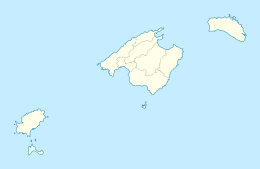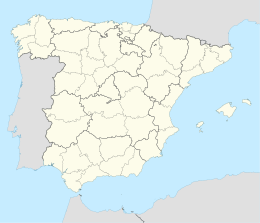 Flag of Mallorca | |
 Sentinel-2 image of Mallorca and Cabrera with enhanced natural colors | |
| Geography | |
|---|---|
| Location | Mediterranean |
| Coordinates | 39°37′N 2°59′E / 39.617°N 2.983°E |
| Archipelago | Balearic Islands |
| Total islands | 5 |
| Major islands | Balearic Islands |
| Area | 3,640.11 km2 (1,405.45 sq mi) |
| Highest elevation | 1,436 m (4711 ft) |
| Highest point | Puig Major |
| Administration | |
Spain | |
| Autonomous Community | Balearic Islands |
| Province | Balearic Islands |
| Capital and largest city | Palma (pop. 430,640) |
| Government | Council of Mallorca |
| President | Llorenç Galmés Verger (PP) |
| Demographics | |
| Demonym | Mallorcan |
| Population | 940,332[1] (2023 Official estimate) |
| Pop. density | 258.33/km2 (669.07/sq mi) |
| Additional information | |
| Anthem: La Balanguera | |
 | |
Mallorca,[a] or Majorca,[b][2][3] is the largest of the Balearic Islands, which are part of Spain, and the seventh largest island in the Mediterranean Sea.
The capital of the island, Palma, is also the capital of the autonomous community of the Balearic Islands. The Balearic Islands have been an autonomous region of Spain since 1983.[4] There are two small islands off the coast of Mallorca: Cabrera (southeast of Palma) and Dragonera (west of Palma). The anthem of Mallorca is "La Balanguera".
Like the other Balearic Islands of Menorca, Ibiza, and Formentera, the island is a highly popular holiday destination, particularly for tourists from the Netherlands, Germany, and the United Kingdom. The international airport, Palma de Mallorca Airport, is one of the busiest in Spain; it was used by 28 million passengers in 2017, with use increasing every year between 2012 and 2017.[5]
- ^ Instituto Nacional de Estadística, Madrid, 2023.
- ^ "Mallorca: definition". Collins Dictionary. n.d. Archived from the original on 26 December 2018. Retrieved 16 October 2010.
- ^ Keenan, Steve (6 July 2009). "Mallorca v Majorca: which is correct?". The Times. London. Archived from the original on 6 June 2010. Retrieved 7 April 2013.
- ^ Tisdall, Nigel (2003). Mallorca. Thomas Cook Publishing. p. 15. ISBN 9781841573274.
- ^ "Presentación". AENA Aeropuerto de Palma de Mallorca (in Spanish). Archived from the original on 11 November 2014. Retrieved 7 September 2017.
Cite error: There are <ref group=lower-alpha> tags or {{efn}} templates on this page, but the references will not show without a {{reflist|group=lower-alpha}} template or {{notelist}} template (see the help page).

